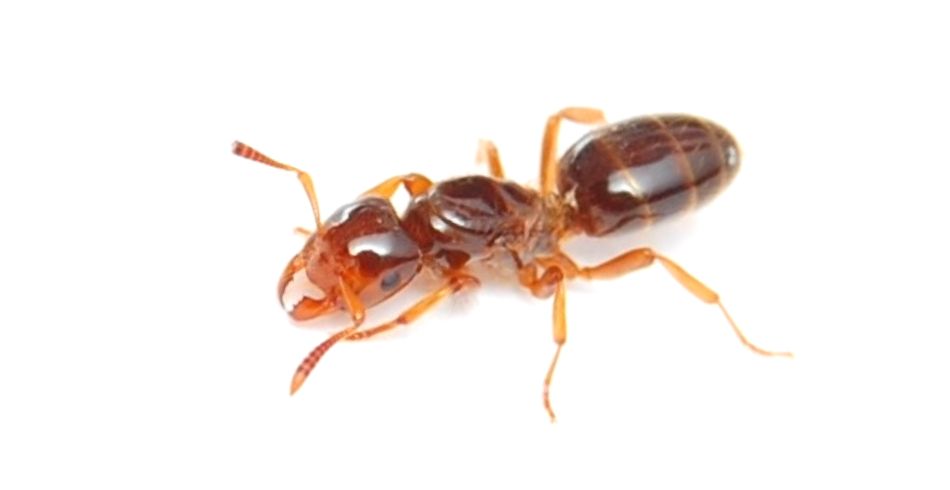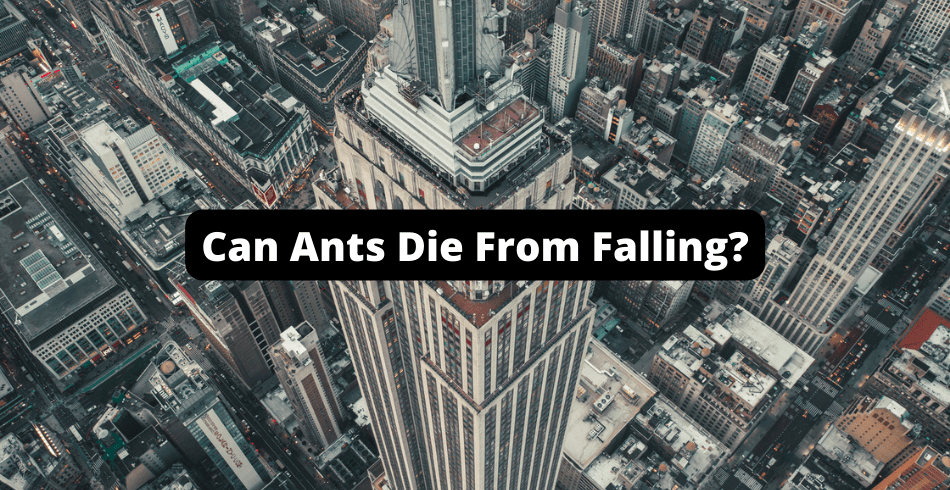The fall from any height is caused by gravitational force. The damage from falling sustained by the object, in this case, the ant, depends on several factors.
These include the falling distance, the object’s size, air resistance, and the mass and shape of the falling object.
Bringing these factors together, but mainly due to its size and mass, an ant won’t die from falling.
This article explains what happens to an ant when it falls from a high building. We also address the issue of whether the nature of the surface can kill a falling ant.
Most importantly, we explain what happens when an ant falls from a tall skyscraper like the Empire State Building.
Can ants survive any fall?
A fall is the displacement of an object, like an ant, from a higher surface to a surface lower than the original one. Ants survive falling from any height, short or towering, without sustaining damage.
Why is that?

For any object to survive a fall, which applies to an ant, it must hit the surface it’s falling on with force insufficient to cause significant damage.
The force of hitting the surface is partly determined by the mass of the ant and the distance between the two surfaces.
Ants are tiny creatures weighing about 1-5 mg, even though some larger ants weigh a little more.
Primarily due to the ant’s negligible weight, even if it falls from high heights, it will not hit the lower surface at a force likely to cause any damage.
For this reason, ants fall from any height without getting hurt or dying.
Relevant Viewing:
Reference: https://link.springer.com/article/10.1134/S003103010909007X, https://www.bbc.com/news/magazine-29281253
Why do ants not die when they fall?
The speed at which a falling object hits a static surface is a factor of the falling distance, the object’s size, air resistance, and the mass and shape of the falling object.
For two or more objects falling the same length and subject to the same air conditions, the object’s mass is the most crucial factor determining the level of hurt from the fall.
An ant’s small weight is a significant enabling factor influencing falling from any height without dying.
Since the mass of the ants is tiny, resistive air pressure makes them fall slower.
A slower fall on impact with the static surface means less stoppage force and minimal chances of death.
An additional factor preventing the ant from dying is its biology. The ant’s exoskeleton is coated with a hit-resistive material called chitin.

Low mass and a sturdy body, plus resistance to falling conditions, ensure ants can survive even after falling.
Reference: https://escholarship.org/content/qt64k8n0z3/qt64k8n0z3.pdf
Can an ant survive a fall from the Empire State Building?
Aided by its small weight, shape, and atmospheric conditions, an ant would easily survive a fall from the Empire State Building (ESB).
The ESB is over 380m tall and dropping an ant from such a height subjects it to atmospheric conditions affecting the final force with which the ant hits the ground.

Due to the wind’s drag, the ant will encounter air resistance and fall slowly.
Depending on the strength of the wind currents, the ant may not fall in a straight line, and the eventual impact on the ground may be tens of meters away from the building.
Due to the ants’ small size and the influence of the air and wind, the resultant falling speed is insufficient to cause the ant to suffer any damage.
Some ants also take a pitching position when they sense proximity to a landing surface, and this adaptation enables a safer landing.
Reference: https://www.britannica.com/topic/Empire-State-Building, https://escholarship.org/content/qt64k8n0z3/qt64k8n0z3.pdf
Would an Ant Die if it Fell off a Building?
An ant will not get hurt if it falls off a building, and its lower mass means lesser impact when the ant hits the ground.
Ants have a very small mass and a high air resistance, so they fall slowly.
When arriving at the bottom of the building, the force with which they hit the ground is insignificant to cause the ant to die.
Will the ant Die if it Reaches Terminal Velocity?
Newton’s Third Law, which states that every action has an equal and opposite reaction, also applies to gravitational force.
Like all objects, as an ant falls, it reaches a terminal velocity that depends on gravitational force pushing it down and the air resistance pushing it upwards against gravity.
The terminal velocity of a falling object depends on the gravitational force, the object’s mass (weight), and its projected shape (volume).
Terminal velocity is higher if the mass is higher and the shape is regular, like that of a spherical ball.
Ants are estimated to reach a terminal velocity of about 6.4 Km/h, as opposed to humans, estimated to hit a high of 200 Km/h.

So, for an ant, this speed at impact is not lethal.
Technically, it’s not the terminal velocity that kills the ant or smashes an object. It’s the sudden encounter with a static surface.
The sudden stop converts moving energy to kinetic energy.
An impact with the surface at 6.4 Km/h is a good reason an ant walks away from a high fall, but a human at the same height dies.
References: https://escholarship.org/content/qt64k8n0z3/qt64k8n0z3.pdf,
http://hyperphysics.phy-astr.gsu.edu/hbase/airfri2.html,
https://pressbooks.online.ucf.edu/osuniversityphysics/chapter/6-4-drag-force-and-terminal-speed/
Does the landing surface matter when an ant falls?
As discussed in the previous section, the terminal velocity of an ant, or a tiny insect, is not high as it approaches and comes into contact with a static surface.
An ant’s resistance to downward movement is also proportional to the surface of the ant.
Bigger ants may get slightly shocked on rough surfaces, but they dust themselves and walk away.
Regarding damages from falling, the landing surface matters as the body mass increase from small animals to large ones, such as humans.
Falling onto a soft surface like a mattress or a balloon, as opposed to the bare ground, can be the difference between life and death for animals, but it means little to an ant.
Would an ant survive a fall from the empire state building if it landed on a pillow?
Falling at any height and landing in a rough place is risky, and a pillow is a friendlier landing ground than a natural surface.

An ant will not die even on a hard landing. So, landing on a pillow from an Empire State Building fall won’t kill an ant.
Ants have a mass relative to their air resistance advantage.
Additionally, ants fall with their legs fully extended, exaggerating their small body size. Doing so helps them to glide, which decreases the low terminal velocity.
Reference: https://escholarship.org/content/qt64k8n0z3/qt64k8n0z3.pdf
Ants are fall survivors.
From the ensuing discussion, it’s fair to conclude that ants are fall survivors.
Their ability to fall unscathed from the highest points is a result of several factors, and some of the determinants relate to the ant’s size, mass, and shape.
A falling ant takes advantage of its body features and forces of nature.
Gravitational force triggers the speed of an ant’s fall.

However, the air resistance, which determines the terminal velocity, slows the ant’s fall. The ant does not hurt in a fall because the collision force with a static surface is minimal.
Consequently, even if an ant falls from a tall skyscraper like the Empire State Building, it will not die.
The nature of the surface, smooth, soft, ragged, or hard, is critical when the mass of a falling object is large.
The surface condition is minimally helpful to an ant with a negligible mass and a small body that’s further covered with a strengthening coating that takes falling shocks.

